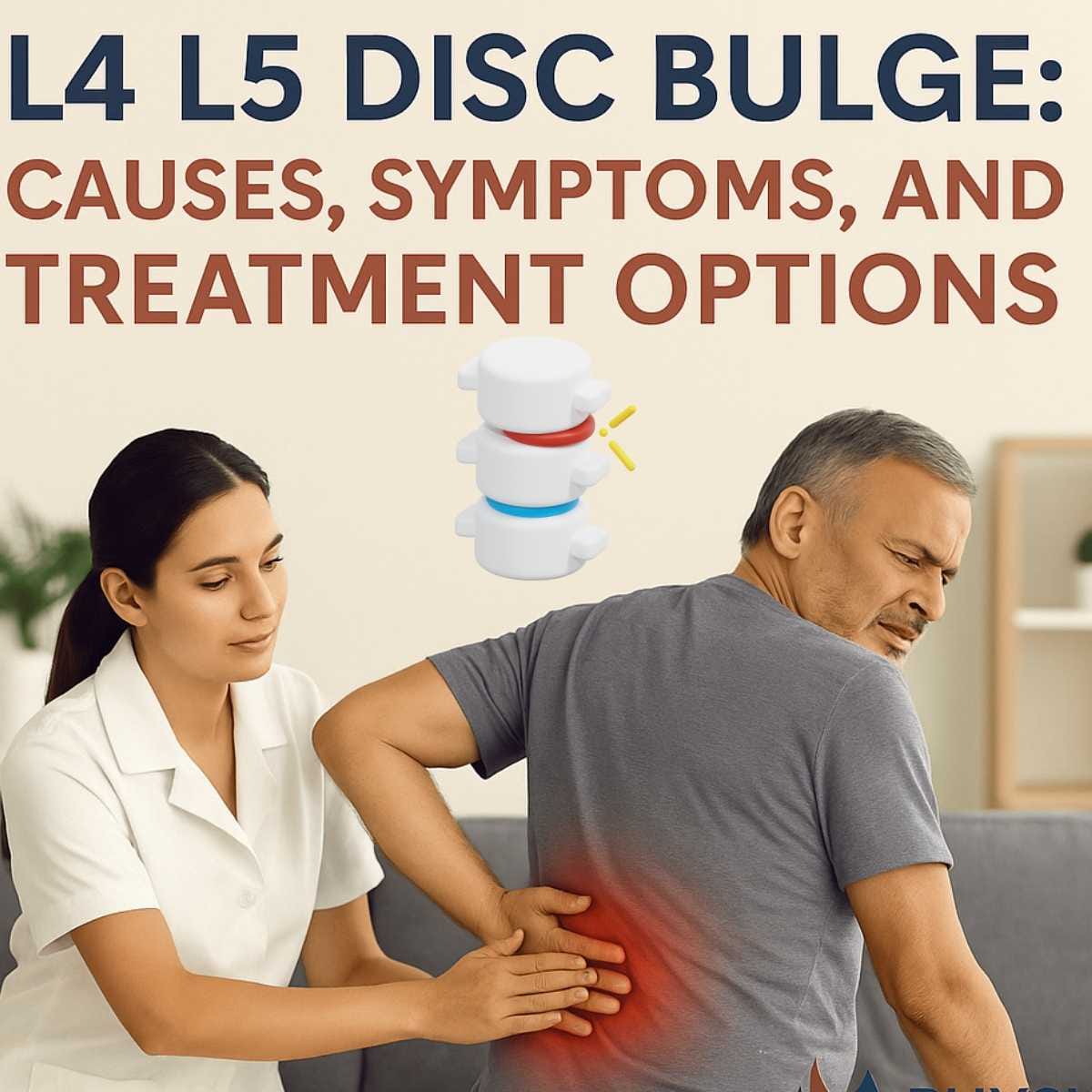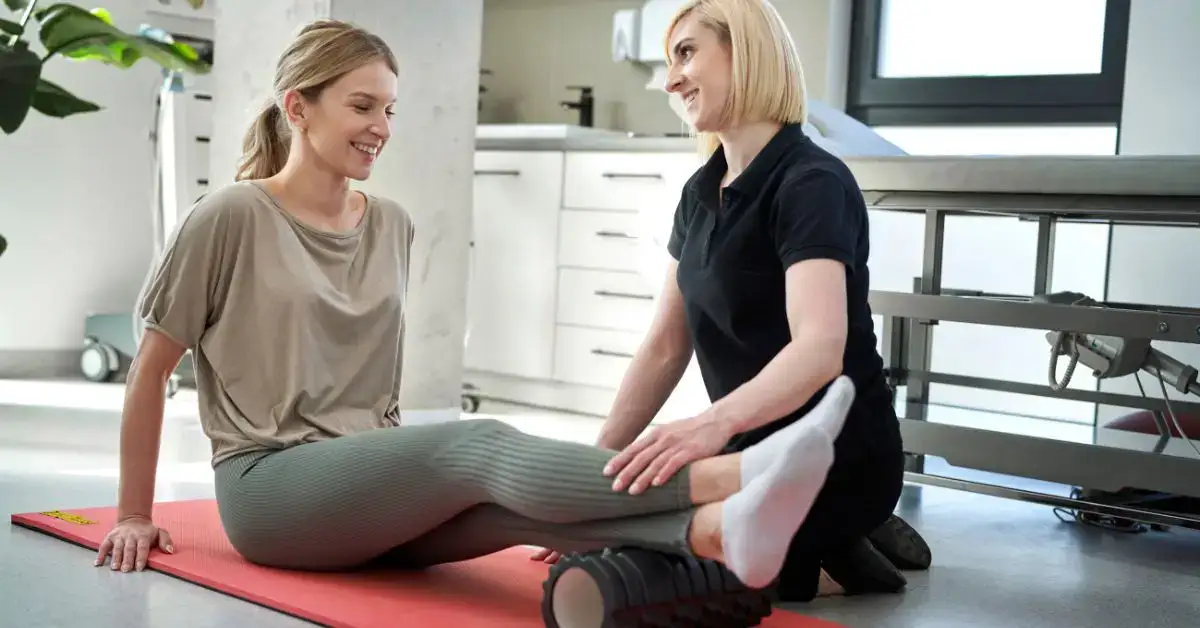Dealing with L4 L5 disc bulge can be incredibly challenging, especially when it disrupts your daily routine. As a physiotherapist, I’ve seen how this condition can cause persistent pain and discomfort. A bulging disc in the lower back is a common issue, but the good news is that with the right treatment, it can be managed effectively.
In this article, I’ll walk you through everything you need to know about L4 L5 disc bulge, including its causes, symptoms, and the treatments that can help alleviate the pain. I’ll also introduce you to Physio at Home, which provides physiotherapy services directly at your doorstep, making it easier than ever to manage your condition without leaving your home.
What is an L4 L5 Disc Bulge?
The L4 L5 discs are part of the lumbar spine, located between the fourth and fifth vertebrae in the lower back. These discs act as shock absorbers, allowing for movement and flexibility in the spine. However, when the inner portion of the disc pushes outwards, it creates a bulge. While the disc doesn’t rupture, the pressure can cause pain and discomfort by compressing surrounding nerves.
The L4 L5 disc bulge is one of the most common spinal conditions, often causing lower back pain and, in more severe cases, symptoms like sciatica. This condition may happen due to natural wear and tear or as a result of injury, poor posture, or other factors.
Causes of L4 L5 Disc Bulge
There are several factors that can contribute to an L4 L5 disc bulge. Understanding these causes can help you take preventive measures to avoid further injury.
Aging
As we age, the intervertebral discs naturally lose some of their water content. This leads to reduced flexibility and makes the discs more prone to bulging or herniating. The outer layer of the disc, known as the annulus fibrosus, also becomes weaker over time, increasing the risk of injury.
Poor Posture
Maintaining poor posture for extended periods can strain the lower back and lead to disc issues. Slouching while sitting, leaning forward excessively, or twisting the spine repeatedly can put undue pressure on the L4 L5 discs, leading to bulging.
Repetitive Movements
Certain activities that involve repetitive bending, lifting, or twisting can increase the strain on the lumbar spine. People who work in physically demanding jobs or athletes involved in these kinds of movements are more likely to experience a bulging disc.
Trauma or Injury
Accidents, such as falls or car crashes, can cause sudden and significant pressure on the spine. A traumatic injury can rupture or damage the disc, causing it to bulge and press on surrounding nerves.
Obesity
Carrying extra weight puts additional strain on the spine. This added pressure can increase the risk of disc degeneration and bulging, especially in the lumbar region.
Genetics
Some individuals may be genetically predisposed to developing spine problems. If there is a family history of disc-related issues, you might be more likely to experience a bulging disc at some point in your life.
Symptoms of L4 L5 Disc Bulge
The symptoms of an L4 L5 disc bulge vary depending on the severity of the condition. Some people may experience only mild discomfort, while others may face more intense pain and difficulty moving. Here are the most common symptoms:
Lower Back Pain
This is the most common symptom and can range from a dull ache to sharp, stabbing pain. The pain might worsen when bending, twisting, or standing for long periods. In some cases, the pain may radiate to the
buttocks or legs.
Sciatica
When the bulging disc presses on the sciatic nerve, it causes sciatica—pain that radiates from the lower back down the leg, often accompanied by a tingling or burning sensation. This is one of the most noticeable symptoms of a L4 L5 disc bulge.
Numbness or Tingling
A bulging disc can also compress the nerves in the spine, causing a pins and needles sensation or numbness, especially in the legs or feet. This symptom is often a sign that the nerves are being affected by the disc bulge.
Muscle Weakness
In severe cases, a bulging disc can lead to muscle weakness in the legs. This makes it difficult to walk, stand, or perform simple movements. Muscle weakness often occurs because the nerves controlling the muscles are being compressed.
Reduced Mobility
Pain and stiffness in the lower back can limit your range of motion. Simple tasks like bending, lifting, or sitting can become difficult due to the discomfort caused by the disc bulge.
Diagnosis of L4 L5 Disc Bulge
To determine if you have an L4 L5 disc bulge, a healthcare provider will first perform a physical examination. They’ll assess your posture, movement, and areas of tenderness to help identify the problem.
In some cases, imaging tests such as MRI (Magnetic Resonance Imaging) or CT scans are used to confirm the diagnosis. These tests provide detailed images of the spine, showing the location and size of the bulging disc.
Physiotherapy Treatment for L4 L5 Disc Bulge
Physiotherapy is one of the most effective treatments for managing L4 L5 disc bulge. It offers non-invasive solutions to alleviate pain, improve flexibility, and strengthen muscles that support the spine. Here are some of the key physiotherapy techniques used to treat this condition:
Manual Therapy
Manual therapy involves hands-on techniques to manipulate the spine and soft tissues. These techniques are highly effective in relieving pain and improving spinal mobility. Some examples of manual therapy include:
Spinal Manipulation: This involves applying controlled force to specific areas of the spine to relieve tension and restore mobility. This can be helpful when the disc bulge is causing restricted movement or joint dysfunction.
- Spinal Mobilization: Similar to spinal manipulation, mobilization involves gentle movements of the spine to improve flexibility and reduce stiffness.
- Soft Tissue Manipulation: Massage and other soft tissue techniques are used to reduce muscle tension and alleviate discomfort caused by the bulging disc.
Therapeutic Exercises
Physiotherapists will design an exercise program tailored to your specific condition. The goal is to strengthen the muscles around the spine and improve flexibility to relieve pressure on the L4 L5 discs. Exercises include:
- Core Strengthening: Exercises like bridges, planks, and leg raises target the core muscles to provide better support for the spine.
- Posture Correction: Physiotherapists will teach you proper posture techniques to help prevent further strain on your back and reduce the risk of worsening the disc bulge.
- Stretching: Stretching exercises can improve flexibility in the back and legs, helping to release muscle tension around the affected disc.
Heat and Cold Therapy
Both heat and cold therapy are effective in managing the pain and inflammation associated with L4 L5 disc bulge:
- Cold Therapy: Applying ice to the affected area can help reduce swelling and numb the pain. This is particularly helpful in the early stages of the injury when inflammation is present.
- Heat Therapy: Heat helps relax tense muscles and improves circulation, providing relief from muscle spasms and stiffness.
Traction Therapy
Traction therapy involves using a machine to apply a gentle pulling force to the spine. This helps relieve pressure on the disc and nerve roots, which can alleviate pain and improve mobility. Traction is particularly effective for patients with sciatica caused by a bulging disc.
Dry Needling or Acupuncture
Dry needling and acupuncture are used to target muscle tightness and trigger points that often occur with a L4 L5 disc bulge. These techniques can help reduce pain and promote relaxation in the muscles surrounding the spine.
Physio at Home: Convenient Treatment for L4 L5 Disc Bulge
Managing L4 L5 disc bulge is easier than ever with Physio at Home. Our at-home physiotherapy service brings expert treatment directly to your doorstep, offering several benefits:
- Convenience: No need to travel to a clinic. We come to you, saving you time and energy.
- Personalized Treatment: Each session is tailored to your specific needs, addressing your unique symptoms and recovery goals.
- Expert Care: Our highly trained physiotherapists are experienced in treating L4 L5 disc bulge and will work closely with you to ensure the best possible outcomes.
How to Book a Session with Physio at Home
Booking a physiotherapy session with Physio at Home is simple:
- Visit our Website: Go to the Physio at Home website and select the Book a Session option.
- Fill Out a Quick Form: Provide your contact details and a brief description of your symptoms.
- Confirm Your Appointment: You’ll receive a confirmation email with your booking details.
Take Control of Your Recovery
Living with an L4 L5 disc bulge can be uncomfortable and disruptive, but with the right treatment, you can manage the symptoms and return to an active, pain-free life. Physio at Home is here to make that process easier by providing expert care right at your doorstep. Don’t wait for the pain to get worse—reach out today and take the first step toward a healthier, pain-free future.
If you’re experiencing lower back pain, don’t hesitate to contact Physio at Home for personalized physiotherapy treatment designed to help you recover faster.



